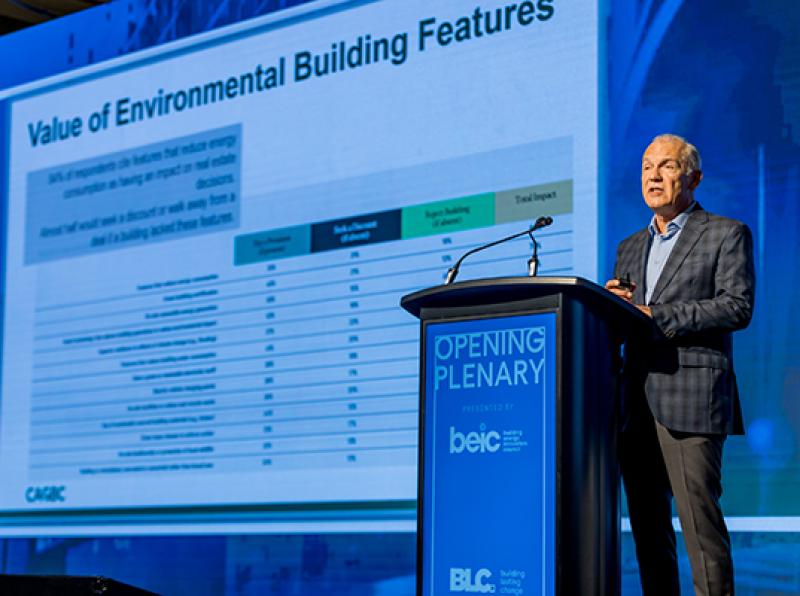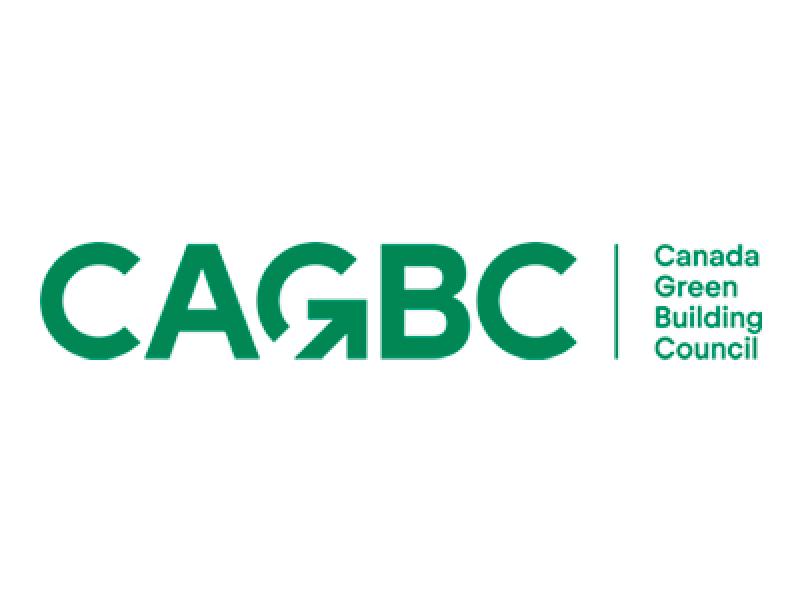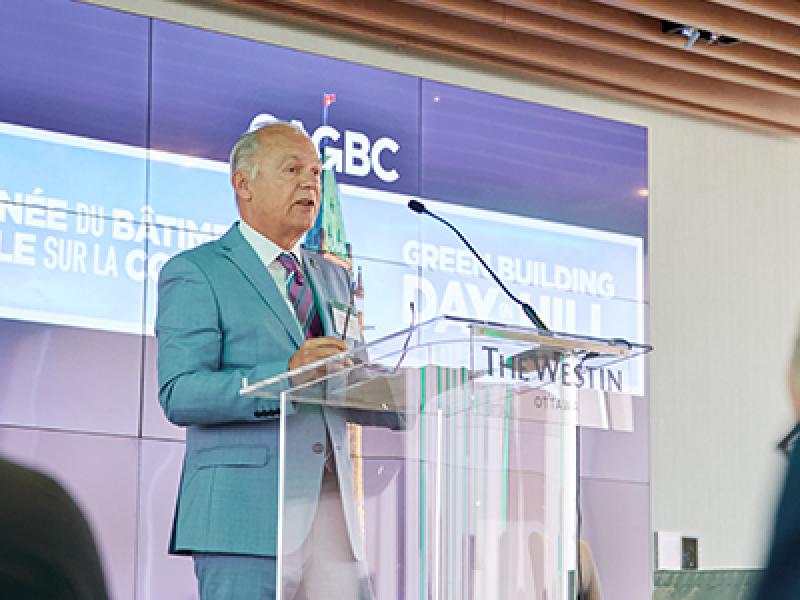
Retrofitting Canada’s aging building stock is no longer just a climate imperative — it’s an economic opportunity we can’t afford to miss.
It’s estimated that 70 percent of today’s existing buildings will still be standing in 2050, making retrofits a cost-effective way to reduce emissions, lower operating costs, and improve asset value. Done right, they also create skilled jobs, stimulate innovation, increase resilience, and support long-term affordability — in other words, a win on every front.
But how do we make retrofit investments more attractive to those bankrolling the upfront costs?
The answer lies in aligning financial systems with building performance — a shift that’s already underway globally. Around the world, governments, institutional investors, and developers are rethinking how capital flows can accelerate climate action — and buildings are a crucial component of that conversation.
On October 16, the Canada Green Building Council (CAGBC) will host a national session on Sustainable Finance & LEED V5 • Unlocking Built Value, featuring an international panel of green building experts. The event will explore how voluntary certifications can enhance access to green bonds, sustainability-linked loans, and other financial instruments — and what that means for owners, lenders, and regulators navigating the market.
Ultimately, the goal is clear: to ready Canada’s financial systems to support the performance, resilience, and returns that the market is already demanding. Here are four actionable strategies to advance that goal:
1. Capital: Structure investments to reward performance
Despite growing demand, the primary market barrier is a lack of financing at rates and terms that reflect the long-term value of retrofits. Outside of the Canada Infrastructure Bank’s retrofit initiative, there are no dedicated federal financing programs for the retrofit market. Approaches by other levels of government and utilities vary in reach and effectiveness.
Unlike other sectors that benefit from government guarantees or blended capital structures, retrofit projects are often left to navigate a fragmented and risk-averse lending environment. The result: many viable projects stall at the feasibility stage.
CAGBC is working with partners to develop financing solutions that reward performance and lower transaction costs — from outcome-based loan products to public-private capital stacks that reduce investor risk. The goal is to make retrofits not just technically feasible, but financially routine. Insights from CAGBC’s recent report, Rapidly Scaling Canada’s Deep Retrofit Market, reinforce this message: retrofits are a proven investment — but without capital that recognizes and rewards their value, the market won’t scale at the pace required.
2. Performance: Standardize outcomes to build investor confidence
One of the reasons stakeholders hesitate is a lack of consistent, comparable performance assessment.
As Thomas Mueller, CAGBC President and CEO, explains: “Investors hesitate to back projects when the outcomes are uncertain. Standardizing the assessment of proposed retrofits and reliable verification of results are essential in reducing risk for investors and providing a foundation to scale retrofits.”
CAGBC is addressing this challenge through tools like Investor Ready Energy Efficiency (IREE) certification, which standardizes retrofit evaluation and provides confidence in forecasted outcomes. It is required for retrofit projects financed by the Canada Infrastructure Bank. Additionally, CAGBC is working on Zero Carbon Building – Performance Standard™ updates that will provide recognition for building performance and align with carbon transition planning for portfolios of buildings. Launching in 2026, the updated standard will help close the performance gap.
For investors, this kind of standardization and transparency reduces risk and increases confidence — helping ensure that existing properties don’t become stranded assets in the future.
3. Classification: Advance a green taxonomy that supports real estate
Canada’s sustainable finance ecosystem is maturing, but it still lacks a foundational piece: a clear, credible classification system that defines which economic activities can be considered environmentally sustainable — also known as a green taxonomy. The federal government supports the development of a green taxonomy, following successful efforts in the EU, China, and Australia, which already use taxonomies to guide investments in decarbonization and attract capital to their markets. A taxonomy isn’t just a technical tool. It’s a market signal — and can act as a financial accelerator.
Buildings are among the top five sectors identified for a Canadian taxonomy. A well-designed taxonomy would define what qualifies as a “green” or “transition” investment in the building sector, support ESG-aligned financial products like green bonds and transition loans, and reduce investor uncertainty. It would help prevent greenwashing while unlocking capital for deep retrofits and new construction designed to meet Zero Carbon Building or LEED® standards.
CAGBC is advocating for the development and release of a green and transition taxonomy as announced in the fall of 2024 and promised in the last election. We are ready to work with the federal government to ensure the taxonomy reflects Canadian market realities while aligning with international standards. A strong domestic framework would give developers, financial institutions, and governments the clarity they need to act confidently, ensuring building investments advance environmental and social goals.
4. Valuation: Modernize building appraisal to reflect performance
The value of investments in new projects and retrofits to improve the environmental performance of buildings isn’t captured by current appraisal methods. Despite mounting evidence that LEED-certified and low-carbon buildings can show better net operating income, command higher market value and lower operating costs, these benefits rarely show up in underwriting or valuation models.
This disconnect limits loan-to-value ratios, weakens business cases, and discourages investment among owners managing large portfolios and developers of new projects.
At Building Lasting Change 2025, CAGBC and REALPAC announced a joint initiative with leading appraisal firms and commercial building owners. The goal is to review valuation practices and identify the financial and non-financial metrics that would capture investments in environmental performance. This would need to be accompanied by educating and training appraisers sustainability as it relates to valuation and aligning underwriting criteria with building performance data.
Conclusion
Canada’s retrofit economy is gaining momentum. But to grow its potential, we need to align financing mechanisms to scaling high-performance buildings.
CAGBC is helping lead this alignment through project certifications, research, training, and policy engagement. The goal is to reduce risk, create value for investors and unlock access to financing for owners to future-proof assets in a changing climate and economy.
The systems are evolving. The opportunity is real. Now is the time to bring finance and performance into alignment.
************************************************************************
This conversation continues October 16, when CAGBC hosts a virtual session on Sustainable Finance & LEED v5.








